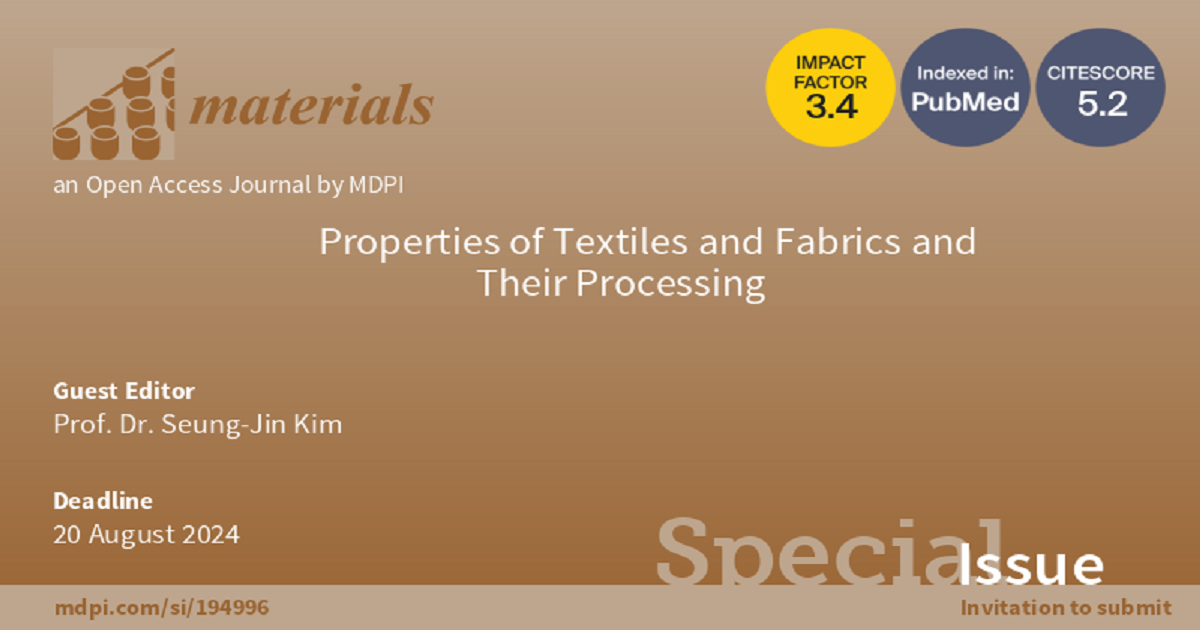Properties of Textiles and Fabrics and Their Processing
A special issue of Materials (ISSN 1996-1944). This special issue belongs to the section "Polymeric Materials".
Deadline for manuscript submissions: closed (20 August 2024) | Viewed by 7741

Special Issue Editor
Interests: warm/cool feeling; ceramic-embedded fabric; far-infrared thermal manikin; eco-friendly yarn; textured yarn; fabric hand; protective fabric; wear comfort; weaving loom
Special Issue Information
Dear Colleagues,
Various types of textile materials, such as fibers, yarns, nonwoven materials and fabrics, and even fiber-reinforced composites, have been used as clothing materials worn by human beings and as modern engineering materials in different industrial fields. The fiber materials used as modern engineering materials are known as Kevlar, carbon and various high-performance fibers, including nano-fibrous materials. The processing and properties of these various textile materials, including fibers and fabrics, play a very important role in producing new textile goods and are critical to improve their new functions. Therefore, many studies in these areas have been conducted in the last several hundred years.
Textile materials are divided into two categories: One includes fashion textiles using eco-friendly fibers, for which the wear comfort and functional properties, such as stretchability, breathability, and absorbing and drying properties, have been improved; processing technologies, such as coating, laminating and hot melt, have been developed to improve their advanced functions (water repellency, water proof ability and vapor permeability). In addition, advanced industrial textiles have been developed and produced using various advanced fiber materials (Kevlar, carbon and other high-performance fibers) and nonwoven materials including nano-technology.
The aim of this SI (Special Issue) is to present and understand recent, advanced new technologies by investigating developing trends in advanced textile materials, the improvement of their properties, and new processes. In-depth observations related to the processing and properties of textiles and fabrics are needed for practical applications of this newly developed technology in commercialized fields through mutual communication with all scientists in this area.
In particular, through this SI, in-depth consideration will be bridged with new research areas conducted in the near future, i.e., digital transformation in the development of new fabrics; AI-aided design technology; and the application and development of IoT and RAIN RFID in the textile industry.
Prof. Dr. Seung-Jin Kim
Guest Editor
Manuscript Submission Information
Manuscripts should be submitted online at www.mdpi.com by registering and logging in to this website. Once you are registered, click here to go to the submission form. Manuscripts can be submitted until the deadline. All submissions that pass pre-check are peer-reviewed. Accepted papers will be published continuously in the journal (as soon as accepted) and will be listed together on the special issue website. Research articles, review articles as well as short communications are invited. For planned papers, a title and short abstract (about 250 words) can be sent to the Editorial Office for assessment.
Submitted manuscripts should not have been published previously, nor be under consideration for publication elsewhere (except conference proceedings papers). All manuscripts are thoroughly refereed through a single-blind peer-review process. A guide for authors and other relevant information for submission of manuscripts is available on the Instructions for Authors page. Materials is an international peer-reviewed open access semimonthly journal published by MDPI.
Please visit the Instructions for Authors page before submitting a manuscript. The Article Processing Charge (APC) for publication in this open access journal is 2600 CHF (Swiss Francs). Submitted papers should be well formatted and use good English. Authors may use MDPI's English editing service prior to publication or during author revisions.
Keywords
- intelligent and smart textiles
- medical and protective fabrics
- green and recycled textiles
- eco-friendly yarn processing and its properties
- high-performance fabrics and their properties
- bio-degradable fibers and their properties
- water/energy-saving dyeing process
- processing technologies in weaving/knitting and their properties
- nonwoven and electro-spinning technologies with nano-fibers
- CAD and CAM design technology
Benefits of Publishing in a Special Issue
- Ease of navigation: Grouping papers by topic helps scholars navigate broad scope journals more efficiently.
- Greater discoverability: Special Issues support the reach and impact of scientific research. Articles in Special Issues are more discoverable and cited more frequently.
- Expansion of research network: Special Issues facilitate connections among authors, fostering scientific collaborations.
- External promotion: Articles in Special Issues are often promoted through the journal's social media, increasing their visibility.
- Reprint: MDPI Books provides the opportunity to republish successful Special Issues in book format, both online and in print.
Further information on MDPI's Special Issue policies can be found here.






